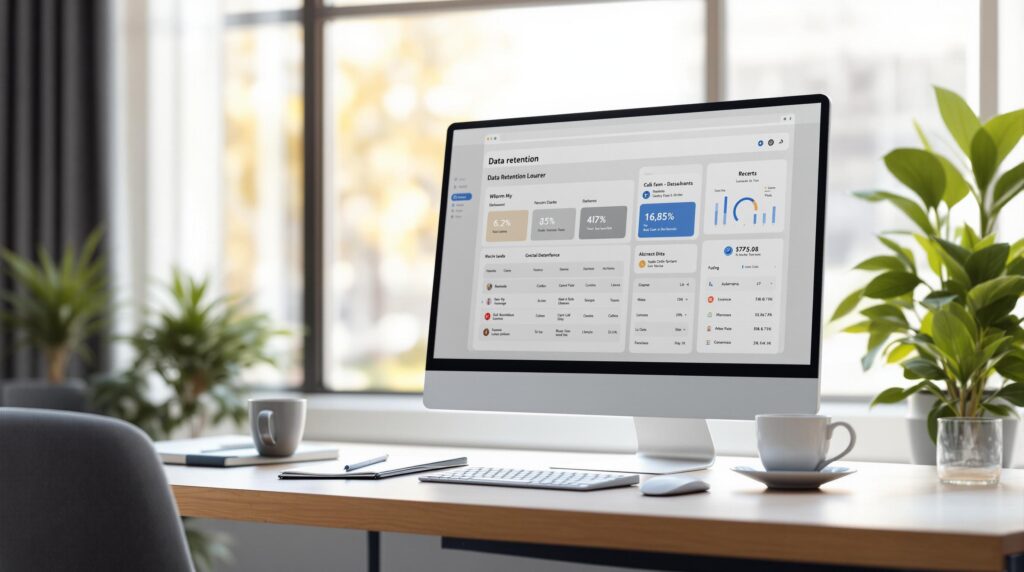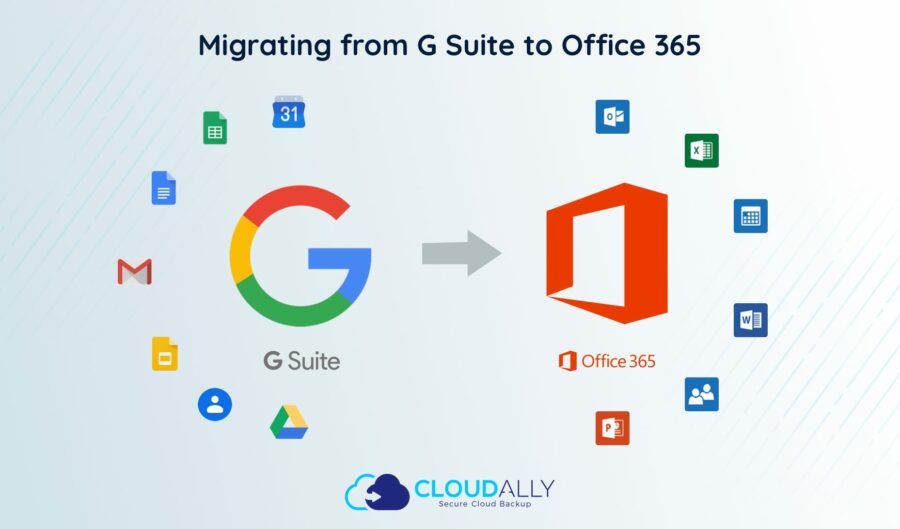Managing SaaS data effectively ensures compliance, reduces costs, and protects against risks like data breaches and regulatory fines. Here’s a quick guide to the best practices:
- Sort Data by Type and Compliance Rules: Categorize data (e.g., financial records, PII, health information) and align retention with regulations like GDPR or HIPAA.
- Set Clear Time Limits for Data Storage: Define retention periods based on legal and business needs, such as 7+ years for financial records.
- Automate Data Removal: Use tools in platforms like Microsoft 365 or Google Workspace for automatic, secure deletions.
- Use Safe Deletion Methods: Implement secure methods like cryptographic erasure and maintain detailed deletion logs.
- Check and Update Storage Rules Often: Review policies quarterly to adapt to changing regulations and business needs.
- Train Staff and Control Data Access: Use role-based access controls (RBAC) and train employees on retention policies and secure data handling.
- Use Backup Tools for Long-term Storage: Invest in third-party backup solutions for extended retention, compliance, and recovery options.
Quick Comparison of SaaS Retention Features
| Platform | Retention Tools | Automatic Deletion | Backup Needs |
|---|---|---|---|
| Google Workspace | Retention settings, labels | Yes | Third-party recommended |
| Microsoft 365 | Retention policies, eDiscovery | Yes | Third-party recommended |
These steps help balance compliance, cost efficiency, and data security. Regularly updating your policies ensures your SaaS data management stays effective and compliant.
Data Retention in Salesforce: Best Practices & Tools
1. Sort Data by Type and Compliance Rules
Sorting data is a crucial step in building a strong SaaS retention strategy. Start by performing a detailed data audit to identify and organize the types of information your organization manages through platforms like Microsoft 365 and Google Workspace.
Organizing data properly helps meet compliance standards and minimizes the risks of keeping data too long or deleting it too soon.
Here’s a simple way to categorize data based on sensitivity and regulatory requirements:
| Data Type | Common Retention Requirements | Key Considerations |
|---|---|---|
| Financial Records | 7+ years | Tax regulations, SOX compliance |
| Personal Data (PII) | Duration of business relationship + legal period | GDPR compliance, right to erasure |
| Health Information | Minimum 6 years from creation/last use | HIPAA requirements, secure storage |
| Operational Data | Based on business needs | Internal policies, business continuity |
“GDPR mandates that personal data processing be limited to what is necessary for its purpose.”
Standardizing how you classify data ensures consistency across all SaaS platforms. For example, if you’re handling protected health information (PHI), ensure retention settings are configured to flag and keep these records for at least six years, as required by HIPAA.
Automated tools can make this process simpler by scanning your SaaS data and applying retention rules automatically.
To stay compliant with changing regulations, review and update your retention policies every year. Keep detailed records of your retention decisions to ensure you’re prepared for audits.
Your documentation should cover:
- Clear definitions of data categories
- Retention periods for each category
- The regulations that inform retention requirements
- Assigned roles and responsibilities for managing data
Once your data is sorted and categorized, the next step is setting specific storage time limits that align with both compliance rules and your business needs.
2. Set Clear Time Limits for Data Storage
Once you’ve sorted data by type and compliance rules, it’s time to define how long each type should be stored. The required duration depends on both legal obligations and business needs.
For example, financial records may need to be stored for 7+ years, while communication logs might only need 3-5 years. When using platforms like Microsoft 365 or Google Workspace, consider a tiered strategy: archive older, less critical data and store it using budget-friendly options.
Sensitive data requires extra care. Set up automatic deletion policies to ensure it’s removed once it’s no longer needed for compliance or business purposes.
Make sure to document everything – retention timelines, legal reasons, disposal methods, and who is responsible. This will help maintain compliance and accountability.
Automated tools can simplify this process by enforcing retention rules, tracking timelines, sending alerts for deletions, and keeping audit logs across your SaaS platforms.
“Retaining data for too long can increase the risk of data breaches, slow down systems, and lead to non-compliance with legal requirements. It can also result in unnecessary storage costs and make it more difficult to manage and locate specific data.” [1]
Pro Tip: Review your storage costs every quarter. This helps you spot and cut unnecessary expenses tied to outdated data [2].
Once these time limits are in place, the next step is to automate the data removal process to streamline enforcement.
3. Set Up Automatic Data Removal
Many SaaS platforms now include tools for automating data removal. For example, Microsoft 365 and Google Workspace let administrators create retention policies that automatically delete data based on factors like content type, location, or user group.
To get started, configure retention rules in your SaaS platform’s admin console. Use secure deletion methods such as cryptographic erasure, which permanently removes data by encrypting it. It’s also a good idea to set up alerts to notify administrators before large-scale deletions occur.
Here’s a quick look at how some major platforms handle automatic deletion:
| Platform | Automatic Deletion |
|---|---|
| Google Workspace | Yes |
| Microsoft 365 Email | Yes |
| Microsoft OneDrive | Yes |
Pro Tip: Test your automatic deletion setup with sample data first. This helps uncover any issues before rolling it out fully.
Make sure to document your automated removal rules, schedules, and who is responsible for overseeing them. For data that requires longer retention, think about adding a cloud-to-cloud backup solution. This gives you access to critical historical data while still enforcing daily retention policies [4].
Automating data removal not only helps meet compliance standards but also streamlines operations by ensuring retention policies are applied consistently. However, don’t overlook the importance of secure deletion methods to minimize risks of data recovery.
4. Use Safe Data Deletion Methods
Properly deleting data is essential for meeting regulatory requirements and protecting sensitive information. One effective method for large datasets, especially in SaaS environments, is cryptographic erasure, which ensures data is securely removed.
For platforms like Microsoft 365 and Google Workspace, consider these approaches:
- Cryptographic erasure for securely removing large datasets.
- Soft delete for temporary removals, allowing recovery if needed.
- Permanent delete for routine file cleanups.
Many SaaS platforms include built-in tools to manage and verify deletions. For example, Microsoft 365’s Recoverable Items folder retains deleted emails for 30 days before permanently removing them.
To enhance security, always encrypt data during storage, use the platform’s native deletion tools, and rely on automated systems to track and verify deletions. Keep detailed logs of all deletions, including what was deleted, when, and by whom. These logs not only ensure compliance but also provide an audit trail to identify potential issues.
Different types of data may require tailored deletion methods. For example, customer records often demand stricter processes compared to temporary system logs. Align your deletion practices with your data classification policies and compliance needs [1][3].
If your organization needs to retain data for extended periods while ensuring secure deletion, third-party backup solutions can offer extra protection. These tools help balance data accessibility with secure removal after retention periods end.
Once you’ve implemented secure deletion methods, make it a habit to regularly review and update your storage rules to stay compliant and efficient.
sbb-itb-3f51f55
5. Check and Update Storage Rules Often
Regularly reviewing and updating storage rules is key to managing SaaS data effectively. This helps ensure your data practices stay aligned with current standards and meet compliance requirements as they evolve.
Schedule quarterly reviews with teams like IT, legal, and compliance. Focus on these key areas:
- Privacy regulation changes that could affect data handling
- Updates in business operations that influence data storage needs
- New technology that could improve how data is managed
Here are some practical steps to consider:
- Leverage administrative tools to track storage patterns and evaluate how well policies are working
- Keep clear records of any policy changes and maintain detailed audit trails
- Test updates in a controlled setting before rolling them out fully
For organizations juggling multiple SaaS platforms, automated tools can be a lifesaver. They can monitor policy changes across different services and notify administrators when adjustments are needed to stay compliant [1][3].
When updating your storage rules, make sure they align with any industry-specific regulations. Regular assessments not only keep you compliant but also help fine-tune your data management practices [3].
Finally, after updating your policies, take the time to train your staff. Everyone needs to understand and follow the new rules to ensure they’re implemented correctly.
6. Train Staff and Control Data Access
After updating your storage rules, make sure employees are properly trained and access to data is tightly managed. Success in data retention depends on knowledgeable staff and strong access controls.
Use role-based access controls (RBAC) to restrict data access according to job responsibilities. Employees should only have access to the data they need for their roles. This minimizes the risk of breaches while keeping daily operations smooth.
Employee training should cover key areas like data classification, retention periods, and secure disposal methods. Strengthen security with tools like multi-factor authentication (MFA), regular system audits, and automated monitoring to catch unusual activity.
Here’s a simple breakdown of access levels:
| Access Level | Data Types |
|---|---|
| Basic User | Public documents, team files |
| Team Lead | Department data, project files |
| Admin | System-wide access, configurations |
Automated monitoring tools can track patterns in data access and flag any suspicious behavior. Protect data with encryption during both transfer and storage. Perform quarterly audits of permissions and immediately revoke access for employees who leave the company.
Establish clear guidelines for handling sensitive data, including:
- Routine audits of access permissions
- Immediate removal of access for departing employees
- Regularly updated training sessions and policies
Ongoing training ensures that employees stay informed about best practices, while maintaining a record of compliance with security standards. Combining training with access controls helps secure active data while supporting long-term storage needs for critical information.
7. Use Backup Tools for Long-term Storage
Storing data for the long haul requires more than the basic retention features of SaaS platforms. Businesses often need to keep data for years to meet legal requirements or operational needs, making reliable backup tools a must.
Here’s what backup tools can do to support extended data retention:
- Automated daily backups to keep your data continuously protected
- Point-in-time recovery to restore data from specific moments
- Granular search options for easy data retrieval
- Compliance features for regulations like GDPR and HIPAA
- Extended or unlimited retention to store data as long as needed
When choosing a backup solution, look for options that combine flexible storage with strong security measures. For example, CloudAlly offers cloud-to-cloud backups with AES-256 encryption and supports popular platforms like Microsoft 365, Google Workspace, and Salesforce.
“A layered backup approach and understanding your SaaS provider’s retention policies ensure data safety and availability.” [4]
To build a solid backup plan, set up automated backups, enable cross-user recovery, and activate anomaly detection. Regularly test your recovery processes to confirm they meet your retention goals. For added compliance flexibility, consider tools that support BYOS (Bring Your Own Storage).
Conclusion
Crafting effective SaaS data retention policies is crucial for navigating compliance challenges while improving data management. These policies serve as the foundation for a strong retention strategy.
The key is finding a balance: keeping the data you need while securely removing what you don’t. This becomes critical when handling sensitive information governed by regulations like GDPR or HIPAA.
Regularly reviewing these policies strengthens data governance. As one expert puts it:
“A layered backup approach and understanding your SaaS provider’s retention policies ensure data safety and availability” [4].
Educating employees and managing access are also essential. When staff members understand their roles in data retention, they actively contribute to maintaining security and compliance.
For long-term storage, dedicated backup solutions offer features that go beyond what native platforms provide. These tools help organizations stay compliant while ensuring their data remains accessible and protected over time.
Retention strategies should evolve alongside regulatory and business changes.
“Organizations should implement retention policies that are based on regulatory requirements and business needs, ensuring that data is not retained longer than necessary” [5].
Staying proactive in updating these strategies ensures compliance and keeps operations running smoothly.
FAQs
What is the recommended retention policy for backups?
The 3-2-1 backup strategy – keeping three copies of your data, using two different storage types, and storing one copy off-site – is a widely trusted approach for safeguarding SaaS data. However, built-in retention features in platforms like Microsoft 365 or Google Workspace often aren’t sufficient for long-term needs. This is where third-party backup solutions come into play.
Cloud-to-cloud backup services offer stronger protection and extended retention options. These solutions not only help meet compliance requirements but also ensure your data is always accessible with features like:
- Automated daily backups to minimize the risk of data loss
- Point-in-time recovery for restoring specific versions of your data
- Unlimited retention to meet long-term compliance needs
| Retention Feature | Benefit |
|---|---|
| Automated Daily Backups | Continuous protection against data loss |
| Point-in-Time Recovery | Restore data from any specific moment in time |
| Unlimited Retention | Flexibility to meet all compliance standards |








